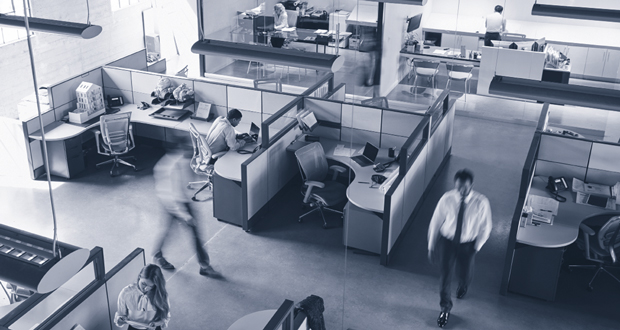 THE WORKPLACE RE-ENTRY EXPERT’S VIEW
THE WORKPLACE RE-ENTRY EXPERT’S VIEW
MICKEY ROONEY,
PROGRAMME DIRECTOR, JLL INTEGRAL
In late April, Jes Staley, CEO of Barclays Bank declared that offices could be a ‘thing of the past’ and did not see the need to bring 7,000 people back into an office post pandemic. Many others believe that the office is far from dead. In fact, we know that offices encourage collaboration, innovation, mentoring and team building – all things remote working struggles to replicate. A recent JLL survey found that 58 per cent of office workers missed the office, with younger cohorts – those 35 and under – showing an even stronger desire to return (65 per cent).
But what all parties agree on is that the ‘great pause’ has been the catalyst for change in our working patterns. For the facilities manager this rapid evolution of the ‘next normal’ offers the expansion of responsibility to a virtual estate requiring support functions not just into the home, but ultimately wherever the client can work.
As we start to re-enter the workplace, the challenges for the short term become more complex and fluid. Space, is the first frontier. Social distancing rules mean the previous occupancy volumes cannot be supported. Hot desking is not a short-term option without a regimented cleaning routine that can guarantee the space is safe for each user. Ingress and egress require levels of controls akin to high-security military and medical facilities, rather than the everyday offices, factories or shops.
Cleanliness, the transmission route for COVID-19 exacerbates the need to keep our personal hygiene at an all-time high, and the same goes for shared surfaces. Most soft services providers offer deep cleaning support, leveraging PPE provisions for their workforce and introducing hydrostatic cleaners. But programming and assuring the effectiveness of the activity poses new challenges that a simple attendance sheet will not fulfil.
Health and wellness, not a common KPI in the performance metrics, but should be considered one of the changes here to stay. The air quality measures that were innovative and still new at the end of last year, are emerging as the must-have metrics as we move through the easing period, not just in the UK but across the globe.
Energy, an interesting challenge when a large portion of corporate building users are still working from home. Energy studies have shown large scale reductions in electricity usage (10 per cent on average) and the mix of generation input changes dramatically (solar, wind, non-coal generation). But when the gross reduction in related GDP activity is considered, energy consumption associated with ‘work’ increases.
Compliance, the legislative requirements placed on the FM are large and far reaching, from engineered systems to water, waste, cleanliness the material condition of the fabric of the building to the behaviours of occupiers.
With these five considerations, the FM needs to prevent them from becoming issues for the service provider, client and occupier. So how to manage all of this and reimagine the new workplace? Like all transformations, the FM needs reliable data. Using sensor information through analytic platforms can provide information on space availability, data registered cleaning routines, air quality, asset, water and travel status. And the occupier needs this data to decide on home or office, what time of day to use the corporate space, or something more flexible. If all parties have the right data, then quality prediction is possible and new working patterns can be established.
The simple solution may seem out of reach as few buildings appear ready to operate this way. However, COVID-19 is likely to drive the need for smarter buildings that can provide the answer for FMs, occupiers and owners alike. So now more than ever the FM’s future looks bright. With virtual workplaces expanding and flexible work patterns increasing, the FM has a whole new set of challenges and solutions they should relish.
 THE FM CONSULTANT’S VIEW
THE FM CONSULTANT’S VIEW
BERNARD CROUCH,
ACUMEN FM
Perhaps first of all we should ask if we should be persuading them to return to the workplace (beyond the occasional team meeting/conference). Although statistics have suggested that many workers would like to remain WFH, other studies have indicated the majority would like to return to the office, the reality seems to sit somewhere around a mix of both, with workers in the workplace two or three days a week and WFH on the other days.
However, we should factor in especially those who either have underlying health problems or have members of their household who are vulnerable from a health perspective and are continuing to self -isolate. I would suggest that it is entirely unreasonable to expect these people to return to the workplace.
The other two groups to mention are:
1. Introverts who have found the lockdown period to be something of a revelation and would prefer to continue to WFH.
2. People with home demands, small children an elderly relative etc. and the flexibility of working from home benefits them, reducing stress and enabling them to juggle a busy lifestyle.
So how about we embrace the idea of some staff working from home, whilst ensuring that those workers are properly supported. In the 1980’s I bought my first house and created a home office. I used it typically for one or two days a month, doing mainly paperwork along with phone calls on a big red BT phone, but it was a mix of home and office working pre the technology that we now have.
Today with broadband, wi-fi, Zoom and Teams, knowledge workers can work anywhere and not just at home or their office. There are indications that we are going to see an increase in local flexible office space, perhaps in nearby high streets, giving workers an opportunity to work in an office space locally.
For FM’s it is ensuring that the home workplace is compliant and also that there is a proper workstation, which of course depends on how provision for this is arranged by the organisation.
Some of the challenges include:
- No direct supervision (some middle managers tend to struggle with this!)
- Security risk, with insecure home wi-fi or un-shredded binned documents
- An erosion of company culture and the impact on individual morale
- Isolation, loneliness, alienation and possible overworking
- Welfare, where an employee has problems that go unnoticed
- Insurance, has the organisation considered WFH within its insurance policies?
In summary, we need to consider all of the above before accepting that workers can just switch to WFH either part or all of the time!





